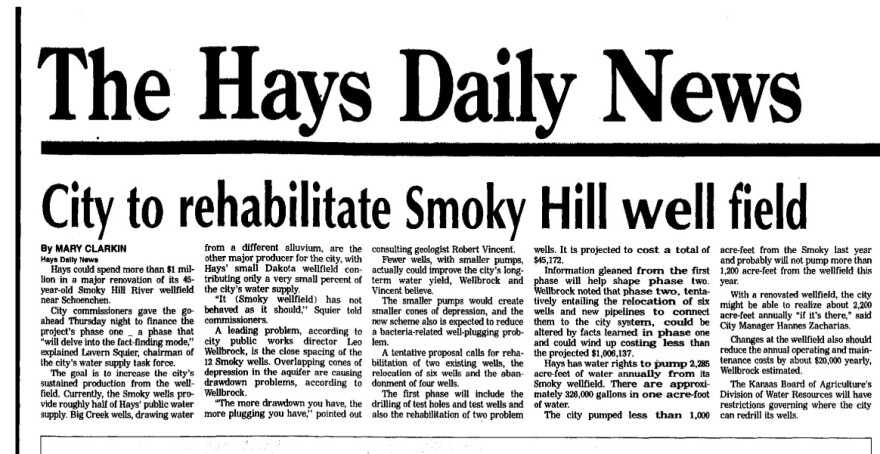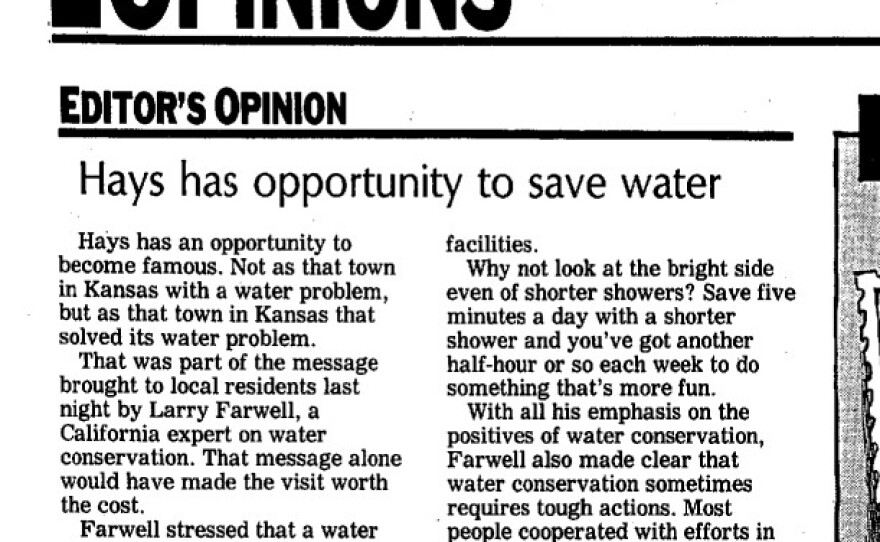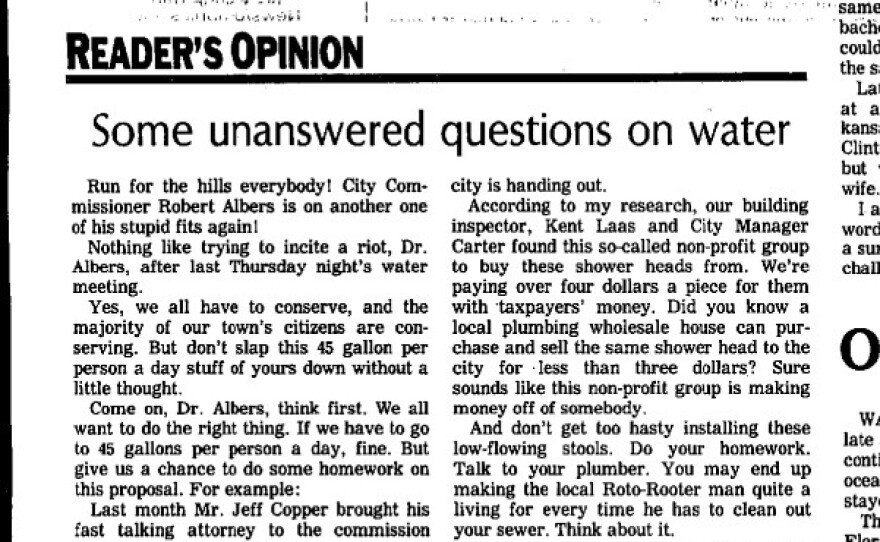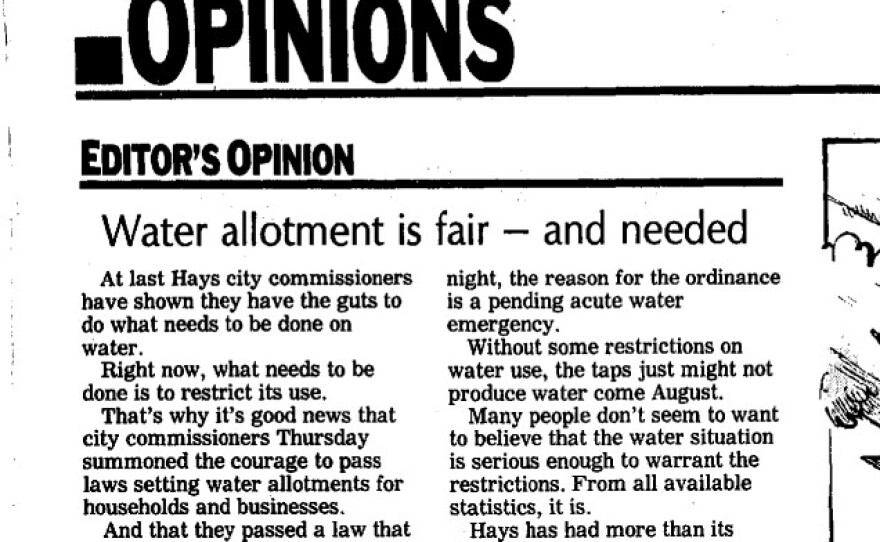Hays, KS— This town’s water problem couldn’t be put off any longer.
After an especially dry year, the wells that pumped water to Hays ran dangerously low in early 1992. If the northwest Kansas town did nothing, people feared they could run out of water by late summer.
Most folks agreed it was an emergency. They just couldn’t agree on what to do about it.
When City Hall suggested installing low-flow toilets, people argued that would just clog things up and overload the town’s plumbers. One city commissioner implored the town’s clergy to preach the water conservation gospel from their pulpits. A letter in the Hays Daily News described a plan for strict water rationing as “trying to incite a riot.”
The city stood at a crossroads.
“Hays has an opportunity to become famous,” a local editorial suggested. “Not as the town in Kansas with a water problem, but as that town in Kansas that solved its water problem.”

While communities across the semi-arid High Plains all face their share of droughts, Hays was — and is — the only city in Kansas with more than 15,000 residents but no sustainable source of water.
It’s caught in the middle. Too far west for reliable rainfall and reservoirs. And too far east to tap into the massive — if disappearing — Ogallala aquifer. So when prolonged drought hits, the town’s bucket of backup plans isn’t exactly overflowing.
That’s why Hays continues its decades-long quest for a sustainable water source today — it’s now in the middle of jumping through legal and regulatory hoops to build a 70-mile pipeline that would bring in water from three counties away.
The 1992 crisis wasn’t the first or last time Hays has had to worry about running low on water. But it marked a turning point.
“It was a wake-up call for the city leaders at the time,” current city manager Toby Dougherty said. “They realized quickly the best thing they can do is start conserving what they have.”

- How Kansas could lose billions in land values as its underground water runs dry
- As fertilizer pollutes tap water in small towns, rural Kansans pay the price
- Here are 7 ways this dry, hot year stacks up against the worst droughts in Kansas history
- Western Kansas wheat crops are failing just when the world needs them most
- How the drought killing Kansas corn crops could make you pay more for gas and beef
- Kansas wildfire responders brace as a dangerously dry, windy season drags on
- How an increasingly brutal Kansas climate threatens cattle’s health and ranchers’ livelihoods
- A hotter, drier climate and dwindling water has more Kansas farmers taking a chance on cotton
Fast forward three decades to a parking lot on the east edge of town.
As the sun creeps toward the horizon, dozens of families mull about at a school district street fair. Some kids line up for a chance to sit in a street sweeper, get a balloon animal or turn an auger dangling from a power company crane.
But in the corner, a big blue local celebrity draws a crowd of his own.
That’s WaterSmart Wally, the mascot of the city’s water conservation program, giving out one high five after another.

And this fuzzy raindrop gets around. Waving from the back of a truck during parades. Dancing at basketball games. Dropping in on classrooms to teach water conservation bingo.
“Kids love him.” Holly Dickman, the city’s water conservation specialist, said. “He loves hugs, so he gets lots of those.”
As far as Dickman knows, she and Wally are the only ones doing their particular jobs in the whole state. And their presence is just one sign of how far Hays has come in its push to absorb water conservation into the town’s culture.
That type of shift can’t happen overnight. And some folks in town still gripe about not being able to water their lawns in the summer or call the strict regulations government overreach.

But two generations of children have now grown up here since the water crisis of 30 years ago. And for many of them, the water-saving practices that make Hays such an outlier in Kansas are just a normal part of life.
When the town held its annual poster contest earlier this year, kids as young as 2nd and 3rd grade drew pictures of people xeriscaping and using rain barrels. One illustrated the benefits of waiting to run your dishwasher until it’s full.
Another depicted a familiar face — WaterSmart Wally — front and center, shedding a horrified tear as he watched the town’s precious resource drip away from a leaky pipe.
“If you grew up here, you lived with it,” Dickman said. “We are that way because we had to be. We have to be.”

The California of Kansas
Twelve years ago, city manager Dougherty boarded a flight bound for Las Vegas to meet with water districts from across the western U.S.
At the time, Hays was riding high from the water-saving measures it put in place in the 1990s, he said, and the city hadn’t thought much about updating them. After all, its efforts were still leaps and bounds above its neighbors.
“We were the leader in Kansas,” Dougherty said. “But I felt like the dumbest kid in the classroom out there.”
Looking around the conference room at the stuff towns out West were doing to conserve water, he quickly realized how far Hays had fallen behind its water scarcity peers and decided to double the town’s efforts.

So he and other city leaders ventured West again and again to pick the brains of some of the country’s most water-conscious cities.
“We have had to look to places like Las Vegas and Tucson and Phoenix,” Dougherty said. “ We stole our landscaping regulations from Utah.”
The city’s cash-for-grass program that pays residents to remove their irrigation-dependent lawns? That idea came from Las Vegas.
The demonstration gardens that were planted around town to show residents how to xeriscape with native plants? Modeled on similar ones in Salt Lake City.
Dougherty said Hays is now studying how Sierra Vista, Arizona, uses wetlands to naturally filter and store its wastewater for reuse.
Even the idea for WaterSmart Wally came from other conservation mascots out West.

Here’s a sprinkling of the ways Hays pushes and pulls its residents to save water today:
- Hays was the first city east of Colorado and north of Texas to start a cash-for-grass program, which offers residents up to $3,000 to replace typical fescue and bluegrass lawns with less thirsty options, such as xeriscaping with rocks and shrubs or planting drought-tolerant types of grass. It remains the only program of its kind in the state.
- Hays built a system that irrigates the town’s golf course and baseball fields with recycled wastewater, known as effluent. That saved more than 100 million gallons of water last year.
- Hays sends welcome buckets to new residents filled with rain gauges, shower timers and a blue dye tablet to check your toilet for leaks. The city has also handed out thousands of low-flow showerheads over the years. Residents can stop by city hall to trade in their old head for a new one anytime at no cost.
- People can still get rebates for installing low-flow toilets — $150 a pop. They can also get $200 rebates for putting in high-efficiency washing machines.
- Unlike other cities that offer utility customers discounts for buying water in bulk, the water rate in Hays gets more expensive the more you use.
- The city has someone on staff whose job it is to personally call customers who are using a lot of water. That can both alert customers to unknown leaks and let them know that they’re being watched.
- Hays has a half-cent sales tax dedicated exclusively to funding water projects, like getting water from new sources or making its existing wells more efficient.
- And finally, one of the most visible measures: outdoor watering restrictions. For the warmest four months of the year, residents can’t water their lawns from high noon until the evening. Homes and businesses can also get a violation for having an outdoor water leak or a sprinkler that sprays into the road year-round.
The Hays Police Department has handed out 85 outdoor watering violations this year so far. First-time violators get a warning and some education about why Hays has to conserve. A second violation within two years comes with a $50 fine. A third violation ups the fine to $200.
But because strict water regulations are so rare in this part of the country, getting one of those warnings might be the first time a Hays newcomer gets the message.
Perry Harrison moved to Hays with his family three years ago after growing up in eastern Texas, where there’s plenty of rainfall. So he was surprised to get a knock on his door from three city employees this summer telling him to turn off his sprinkler.
“We don’t want to be those people, so we were a little mortified,” Harrison said about receiving his first water violation warning. “It was very much a ‘Welcome to having a lawn in Hays, Kansas.’”

That’s all part of changing the culture.
If you’re the only house on your block trying to save water, Dougherty said, it can feel like you’re swimming upstream. But the more people who buy in, the easier it is to follow along.
And one lot at a time, having a brown lawn in Hays has become socially acceptable. In a dry year like this one, it’s the norm.
“Eventually, you’ll be the outlier if you have the lush, irrigated fescue lawn that gets irrigated four times a week,” Dougherty said. “Peer pressure’s a big motivator.”
‘On an island’
So, how big of a dent have all these conservation efforts made in the town’s water use?
Each person in Hays uses an average of 83 gallons of water a day. That’s the same amount of water people use on average in California.
“The problem is we are the only city in Kansas that is acting like … a city in the Mojave Desert,” Dougherty said. “And because of that, a lot of the state looks at us as the poor people that don’t have any water.”
In fact, Hays uses less water per capita than just about any other city in the state.
The state’s most populated city, Wichita, goes through 112 gallons per person each day, according to the most recent statewide water use data from the Kansas Division of Water Resources.
The water district that covers most of Johnson County in the Kansas City suburbs, including Overland Park and Shawnee, pumps out 135 gallons a day per person. In Kansas City, Kansas, people average 147 gallons a day. Even folks in Lawrence — perhaps the most politically progressive place in the state — draw 95 gallons a day.
What about cities with population sizes similar to Hays? Derby, Emporia and Junction City use 104 gallons, 132 gallons and 115 gallons, respectively.
In western Kansas, Hays is even more of an outlier.
Colby, Garden City and Ulysses each use more than double the amount of water per person that Hays does. It’s common for towns across western Kansas — from Elkhart to Scott City to St. Francis— to go through more than 200 gallons of water per person each day.
Even some of the desert cities that Hays took inspiration from haven’t caught up.
In Salt Lake City — where Hays stole its landscaping regulations from — people still go through more than 200 gallons of water a day. Each Phoenix resident uses more than 115 gallons a day. The water district in Las Vegas has a goal to reduce its current 110 gallons per capita rate to fewer than 100 gallons by 2035.
Some of Hays’ western Kansas neighbors have begun implementing their own conservation measures. Garden City installed smart water meters that send hourly readings to the city and alert crews to fix leaks. It also opened a new aquatic center last year that uses 28.4 million gallons less per year than the leaky pool it replaced. Dodge City started irrigating its golf course with reclaimed wastewater.
But every population center in western Kansas besides Hays sits atop the Ogallala aquifer. Even though the aquifer is rapidly depleting, it’s still a more steady water source than anything Hays has nearby.
And as long as there’s water readily available, it can be a challenge to change people’s habits about using it.
“The reality is (other Kansas towns) don’t really have to change their ways that much,” Dougherty said. “We truly are on an island in how we have to look at this.”

But as climate change pushes dry Western weather eastward, Hays could get some company.
Decades from now, the aridification of the Great Plains could lead cities like Wichita or Salina to rethink their own water use. Even cities on the Ogallala aquifer might have to borrow more tips from Hays as wells run low and the cost of buying more water — or running pumps to draw from ever deeper underground — dwarfs the cost of conserving.
The drought this summer has already pushed towns from southwest Kansas to southeast Kansas to enact emergency water-saving measures as their reserves ran low.
Newsha Ajami, a water expert and Chief Research Officer at the Lawrence Berkeley National Laboratory in California, sees similar dynamics play out across the country.
“A lot of communities are grappling with this … drier droughts, longer droughts,” Ajami said, “and a little bit of a shift in mindset from droughts being an occasional thing to maybe droughts are our new reality.”

She and other experts say the key is for towns to focus less on increasing their water supply and more on decreasing their water demand. And even for towns like Hays, there’s more they could do. Using effluent water — water that’s been cleaned but isn’t quite up to drinking standards — to flush toilets or run showers, Ajami said, could reduce indoor water use by 30%.
And she warned that building a pipeline to bring in water from another area — like Hays plans to do — has proven to be disastrous in parts of California. For example, when Los Angeles built an aqueduct to take water from the Owens Valley, it ended up with a dry lake that polluted the air and a series of lawsuits that became known as the California water wars.
“Ultimately,” Ajami said, “it can become more of a problem rather than a solution.”
But it’s rare and impressive, she said, to see a small town implement an aggressive long-term plan to reduce water demand — as Hays has done — rather than cycle through phases of short-term emergency measures each time a drought crops up.
It also shows, Ajami said, that water conservation can be popular even in places like rural western Kansas — more than 70% of voters in Hays’ county backed Donald Trump in 2020 — rather than being cast as a liberal issue that people will only care about in California.
“No matter what political background they have,” Ajami said, “people are driven by what impacts their community.”

Running dry
In a backyard just south of Interstate 70, Dickman, the Hays water conservation specialist, crouches over a patch of surprisingly green buffalo grass.
She plucks a seed from the ground and compares it with another in a bag she uses to demonstrate how the city pays homeowners to convert their yards to this native drought-tolerant plant.
As opposed to typical fescue lawns that need to be watered two or three times a week, buffalo grass can usually get by with just one watering a month.
“Once they get their root systems under them,” Dickman said, “you really shouldn’t have to water them at all.”
That’s the benefit of native plants. They evolved to handle the dry western Kansas climate because their species have thrived here for centuries with no sprinkler system in sight.

And with each new yard that gets this type of makeover, Hays’ limited water supply can stretch a bit further.
It saves Hays money, too. The city estimates that bringing in an acre foot of water — roughly 326,000 gallons — from a new source would cost Hays at least $15,000. But paying to help residents conserve that same amount of water — with, say, three fescue lawn conversions or 25 new low-flow toilets — costs the city far less.
And there’s still room for Hays to get even more efficient with its water.
After three decades of conservation efforts, Dickman said she still runs into folks who have lived in Hays their whole lives who don’t know about the low-flow toilet rebates. That’s why the city continues to push its message — airing radio ads with water-saving tips, handing out shower timers, and sending Wally to schools and parades.
“It takes a long time,” Dickman said. “The job of education and outreach is neverending.”

That job becomes especially critical during a historically dry, hot year like this one.
Hays averages fewer than 24 inches of precipitation a year. The Kansas City area gets more than 40 inches.
During a drought, that gap can get even wider. Less than a foot of rain has fallen on Hays this year — about the same amount it got by this point back in 1991, the year that led to the city’s water crisis. So far this year, parts of eastern Kansas have received roughly three times that amount.
And if the current drought keeps going, Hays might have to ramp up its water conservation efforts. More hours with no outdoor watering. Releasing emergency water reserves. Maybe closing the city pools for a bit. These are realistic possibilities that Hays has had to prepare for.
“It’s not 25 years down the road,” Dickman said. “It’s a matter of how bad is the drought going to be in the next four or five years?”





Even in the aftermath of the 1992 crisis, folks in Hays wondered if conservation alone could be enough for the town to eke out a future in this particularly dry part of Kansas. So the city expanded its main wellfield and tapped additional supply from a deeper aquifer nearby — it’s not sustainable and the water quality isn’t good, but it works as a last resort.
And in 1995, the city bought the R9 ranch three counties south of here with the idea of someday building that 70-mile pipeline.
This type of strategy — known as “buy and dry” — has become common in places like Colorado’s Front Range, where fast-growing cities pay farm owners to use some or all of their water.
It’s much less common on the rural Great Plains, where agriculture drives the local economy more than real estate development. But after looking at bringing water in from reservoirs like Wilson and Kanopolis or rivers like the Saline, Hays determined the ranch’s underground water was the city’s most practical option.

And because Hays has agreed to use about half the amount of water that the ranch is entitled to each year, Dougherty said, it means pumping water to feed a whole town will actually remove less water from the aquifer than pumping water to irrigate crops on that land. The city has already transitioned the surface of the ranch from farmland to a native grass prairie that might someday be open to the public for hiking or hunting, too.
City leaders estimate the future pipeline could give Hays the water it needs to survive for the next 75 years. It might even give the town room to grow — something that’s long been hampered by its shortage of water.
When Doughtery looks at potential industries that Hays could bring to town, his first question is water use. And if a factory would take as much water as 150 homes but only bring in 10 jobs, he said, that’s likely a deal breaker.
Especially in the 1990s and early 2000s when the city was coming out of the crisis, the perception that Hays didn’t have enough water scared some businesses away.
“They didn’t want to take a chance on (Hays),” Dougherty said. “Right now, I think we are on the verge of letting it harm us again.”
Until the city builds the pipeline, he said, the risk of running low on water during future droughts will continue to hang over Hays.

Eleven miles south of town, Hays director of water resources Jeff Crispin hikes down the bank of the Smoky Hill River, which feeds the city’s primary water wells.
Most years, the Smoky is one of the main rivers in northwest Kansas. But after an especially hot and dry summer, this river bed is bone dry.
Tire tracks from joy riding four-wheelers etch crisscrossing patterns in the dirt.
“You look west, you look east, and you don’t see any water,” Crispin said. “Paints a picture of what we’re up against this summer.”
So far this year, the city’s wells are holding steady. But they won’t last forever.
And even as the city gets closer to finally — nearly three decades after purchasing the R9 ranch — getting state approval to build its pipeline, it’ll be at least a few more years before that’s up and running.
So once again, Hays finds itself caught in the middle, hoping the water-saving endeavors it began decades ago can help it hold on a bit longer.
“We have to do the very best we can with what we have,” Crispin said. “But it doesn’t make you feel much better when it’s completely dry down here.”
David Condos covers western Kansas for High Plains Public Radio and the Kansas News Service. You can follow him on Twitter @davidcondos.
The Kansas News Service is a collaboration of KCUR, Kansas Public Radio, KMUW and High Plains Public Radio focused on health, the social determinants of health and their connection to public policy.
Kansas News Service stories and photos may be republished by news media at no cost with proper attribution and a link to the Kansas News Service.













